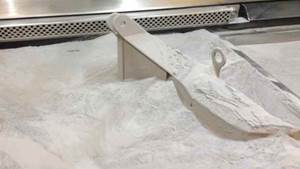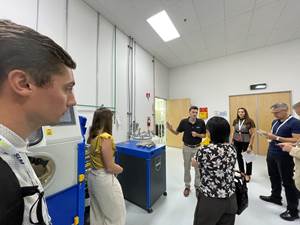Implementing Additive Manufacturing: Is the Juice Worth the Squeeze?
Is the end result of metal AM worth the effort it requires? Students of UL AMCC learn to ask this question at every stage in the process.
Share
Read Next
Although UL is known as an authority on safety, its Advanced Training on Metal Part Production course is more than just safety training. The class, offered at the UL Additive Manufacturing Competency Center (UL AMCCC), covers the entire 3D printing ecosystem within a company.
Each student leaves with an understanding of all the necessary steps to make a metal 3D printed part. In addition to learning how to run, load and unload the machine, students also learn how to receive, test and manage the material; maintain the machine and periphery equipment such as wet separators; and manage waste.
An expression commonly used during UL training encompasses this valuable lesson: “Is the juice worth the squeeze?”
“When working with 3D printing, end users should always be evaluating whether the end result is worth the effort required to obtain it," says Jon Walker, CMTSE, an area sales manager for EOS of North America who has taken the class. An expression commonly used during UL training encompasses this valuable lesson: “Is the juice worth the squeeze?”
"This thought process applies to everything from part design to support structure allocation to postprocessing,” says Walker. Here’s how that process plays out in some of the key stages in additive manufacturing.
Key Stages in the Additive Manufacturing Workflow
Postprocessing
Metal AM parts have a greater amount of postprocessing compared to plastic AM parts, and that needs to be considered from the very beginning in their design. “The challenge here is that if you don’t think about the downstream processes when you are setting up the build or designing the CAD, you are setting up the entire manufacturing chain for failure,” says Ed Tackett, director of educational programs at the UL AMCC.
The course reviews what actually has to happen to link metal AM to the CNC shop, and how the parts benefit. Working with the machine shop and postprocessing team to develop a design can result in a part that needs less cleanup or is easier to set up in a milling machine, for example. Also, consider what will be necessary to machine the part after it is printed, such as soft jaws, and how to provide them to the postprocessing team.
Support Structure Setup
Walker says that one of the most intimidating aspects of DMLS is support structure setup. “The UL training helped me understand the logic built into the Magics software for auto-generation of support structures and how important it is to think about postprocessing requirements when setting up the support structures," he says. “This permits a setup with minimal build time and efficient postprocessing requirements.”
Developing Design Allowables Packabe
The course also helps students develop their design allowables package on AM systems. “Each material for every machine builds a little differently, so students are shown how to figure it out on their own machine(s)," Tackett says. "We provide CAD files, instructions to build them and how to evaluate the results to ensure design engineers know what they can and cannot build at their facility on their equipment. This way, they can channel that information back upstream to the engineers to avoid designing parts that the machine can’t build."
Manage Expectations
Expectations are also discussed. Metal AM's roots are in metalworking, so metalworking, CNC machining, turning and polishing must be understood before attempting to institutionalize AM within a company. However, CNC machining can often be set up and run the next day to make production parts, and that is not the case with AM.
“Many people walk a show like IMTS, see a metal AM machine and think ‘We make metal parts. We should buy one of these.' They buy one and then drop it on the engineer with the same expectations of a CNC machine,” says Paul Bates, general manager of UL AMCC services. By better understanding the full process up front, companies can make better decisions about whether the "squeeze" is worth it.
Related Content
Postprocessing Steps and Costs for Metal 3D Printing
When your metal part is done 3D printing, you just pull it out of the machine and start using it, right? Not exactly.
Read MoreCopper, New Metal Printing Processes, Upgrades Based on Software and More from Formnext 2023: AM Radio #46
Formnext 2023 showed that additive manufacturing may be maturing, but it is certainly not stagnant. In this episode, we dive into observations around technology enhancements, new processes and materials, robots, sustainability and more trends from the show.
Read MoreImplicit Modeling for Additive Manufacturing
Some software tools now use this modeling strategy as opposed to explicit methods of representing geometry. Here’s how it works, and why it matters for additive manufacturing.
Read MoreThe AM Ecosystem, User Journeys and More from Formnext Forum Austin: AM Radio #43
Sessions and conversations at the first U.S. Formnext event highlighted the complete additive manufacturing ecosystem, sustainability, the importance of customer education, AM user journeys and much more.
Read MoreRead Next
Crushable Lattices: The Lightweight Structures That Will Protect an Interplanetary Payload
NASA uses laser powder bed fusion plus chemical etching to create the lattice forms engineered to keep Mars rocks safe during a crash landing on Earth.
Read MoreProfilometry-Based Indentation Plastometry (PIP) as an Alternative to Standard Tensile Testing
UK-based Plastometrex offers a benchtop testing device utilizing PIP to quickly and easily analyze the yield strength, tensile strength and uniform elongation of samples and even printed parts. The solution is particularly useful for additive manufacturing.
Read MoreBike Manufacturer Uses Additive Manufacturing to Create Lighter, More Complex, Customized Parts
Titanium bike frame manufacturer Hanglun Technology mixes precision casting with 3D printing to create bikes that offer increased speed and reduced turbulence during long-distance rides, offering a smoother, faster and more efficient cycling experience.
Read More

















